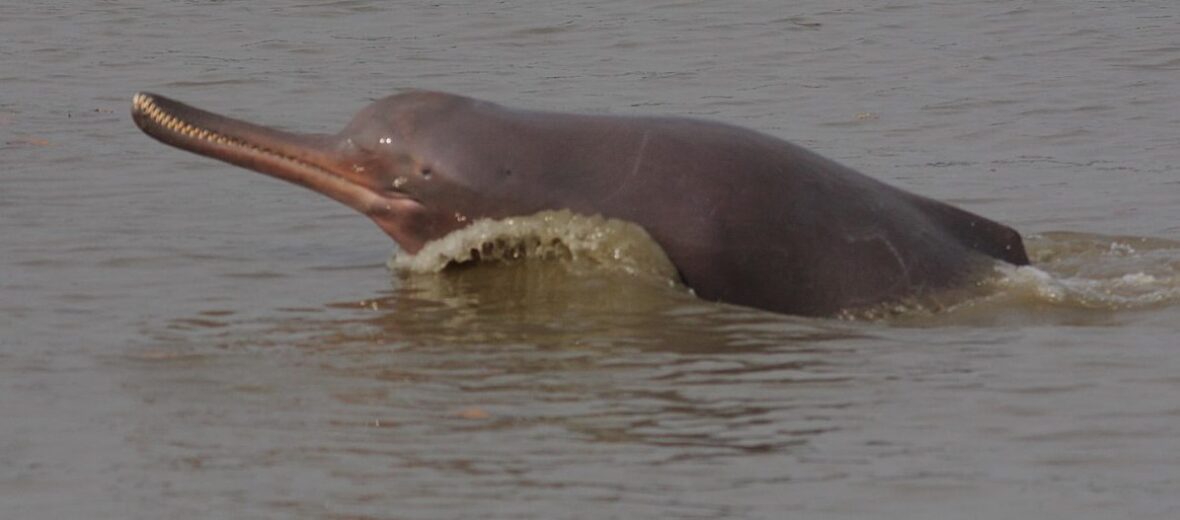
The Indus river dolphin, aka Indus dolphin, Indus blind dolphin, Gangetic dolphin, Ganges susu, Shushuk, Bhulan, side-swimming dolphin, and blind river dolphin, are among the world’s most endangered fresh water river dolphins. They can be found in the fresh water river systems of in Bangladesh, India, Nepal, and Pakistan. These dolphins can be found in waters with large amounts of prey and slower water flow. So they migrate seasonally to achieve these conditions. The Indus river dolphin is listed as Endangered by the IUCN. This is due to pollution, entanglement in fishing gear, habitat degradation, chemical contaminants, noise, overfishing, and boat strike (getting hit by boats and/or their propellers).
First the Stats…
Scientific name: Platanista gangetica
Weight: Up to 200 lbs.
Length: Up to 8.5 feet
Lifespan: Up to 30 years
Now on to the Facts!
1.) Their eyes are so small, that many scientists believe they are functionally blind.
2.) Rather than rely on eyesight to detect prey, they utilize echolocation, like other dolphins. Echolocation is the act where sound is emitted and when it bounces off a target and back to the dolphin, they get a mental picture of what is in front of them. What other animal uses echolocation? If you guessed a bat, you’re correct.
3.) River dolphins use a series of bursts, clicks, and twitters to communicate.
4.) They are solitary, only coming together if food is abundant or to mate.
5.) Indus river dolphins can hold their breath for up to several minutes. But typically do so for 60 – 90 seconds.
But wait, there’s more on the Indus river dolphin!
6.) Their primary prey are carp, catfish, and prawns. They use their teeth to capture and kill their prey but not to chew. Preferring to swallow their prey whole.
7.) Breeding takes place all year.
Did you know…?
These dolphins are at the brink of extinction, with only around 1,000 estimated remaining. Number 1 on the list goes to the Baiji river dolphin.
8.) Females birth a single calf and nurse that calf for up to 1 year.
9.) Unlike the Baiji river dolphin, these dolphins like to breach partially and completely out of the water.
10.) There are arguably 2 subspecies: the Indus river dolphin and the Ganges river dolphin.
But wait, there’s still more on the Indus river dolphin!
11.) Unique among cetaceans, these dolphins prefer to swim on their sides. It is thought that this allows them the ability to use 1 flipper to feel along the river bottom for prey items.
12.) They have a slit on top of their head that acts as a nostril.
Did you know…?
On 20 May 2013, India’s Ministry of Environment and Forests made dolphins official ‘nonhuman persons’ and has forbidden their captivity for entertainment purposes. Keeping dolphins in captivity has to satisfy certain legal prerequisites first.
13.) These river dolphins have been named the National Mammal of Pakistan.
14.) The Ganges subspecies of river dolphin is recognized by India as its National Aquatic Animal and is also the official animal of the Indian city of Guwahati.
15.) Indus river dolphins evolved from a single ancestor around 550,000 years ago.
Now a Short Indus River Dolphin Video!
Be sure to share & comment below! Also, check out the Critter Science YouTube channel. Videos added frequently!
Want to suggest a critter for me to write about? Let me know here.



